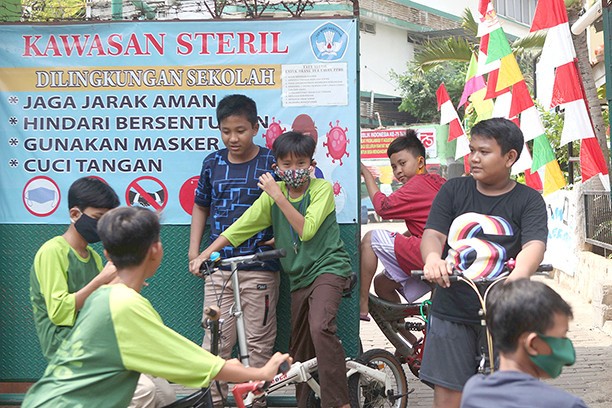COVID-19 infections among children overshadow plans to reopen schools
Indonesia’s pediatricians have raised concerns over the government’s plan to allow more schools to reopen, given that the share of children among COVID-19 fatalities is higher in Indonesia than in other countries.
Change Size
 Children play in front of their school, which is temporarily closed, in Central Jakarta on Friday. The COVID-19 pandemic has forced millions of Indonesian children to study from home. (JP/Seto Wardhana)
Children play in front of their school, which is temporarily closed, in Central Jakarta on Friday. The COVID-19 pandemic has forced millions of Indonesian children to study from home. (JP/Seto Wardhana)
Indonesia’s pediatricians have raised concerns over the government’s plan to allow more schools to reopen, given that the share of children among COVID-19 fatalities is higher in Indonesia than in other countries.
With around 30 percent of Indonesia’s 270 million population being below the age of 18, at least 9,216 children have been infected with the disease in the country as of Aug. 6.
Child deaths accounted for 2.3 percent of the overall COVID-19 death toll, which exceeded 6,000 on Tuesday, official data show.
According to figures from the Indonesian Pediatric Society (IDAI), which are lower than those of the government, 59 COVID-19 deaths and 318 suspected deaths among children were recorded as of Aug. 10.
Forty-two percent of the 59 deaths are children who never got to celebrate their first birthday, followed by children aged 1-5 years (24 percent), 6-9 years (14 percent) and 10-18 years (20 percent).
"Some of the deaths occurred because the children had comorbidity factors, but for others it was because we acted too late,” said IDAI chairman Aman Bhakti Pulungan.
“Even with comorbidity factors, they shouldn't have died,” he said during a press conference held on Monday in protest of plans to reopen schools.
In a separate statement issued on Monday, the IDAI noted that Indonesia was among the countries with the highest COVID-19 case fatality rates (CFR) among people aged 18 years and younger in the Asia-Pacific region.
The CFR among children in the country stood at 1.1 percent, the group said, citing data from the national COVID-19 task force as of Aug. 16. This was much higher than the rates in China, Italy and the United States, each of which stood below 0.1 percent, while in Europe it was 0.3 percent.
The CFR is the proportion of infection cases resulting in death.
Meanwhile, the incidence proportion among children stood at 9.1 percent in Indonesia, which compares to 0.9 percent in China, 1.2 percent in Italy and 5 percent in the US. Incidence proportion is the likelihood of children being infected with COVID-19.
The figures cited were collected by the IDAI from a number of publications, some of which used data prior to August.
One of the reasons why more children in Indonesia contract and die from COVID-19 is malnutrition.
“The prevalence of stunting, malnutrition and pneumonia is still high here. There are also those with tuberculosis and other comorbidity factors.
“Even before the pandemic, we didn’t have a good report card [on health], so when the pandemic hit, the burden instantly tripled,” Aman said.
The double burden of malnutrition in Indonesia has prompted concerns over children’s immunity.
Basic Health Survey (Riskesdas) data from 2018 show that 30.8 percent of children below 5 years of age were stunted, while 2013 data show that the prevalence of obesity among 5-12-year-olds was 18.8 percent.
Children below the age of 14 accounted for 8.4 percent of tuberculosis cases in 2018, while the United Nations Children's Fund (UNICEF) said that pneumonia, congenital diseases and diarrhea were the main causes of death among young children.
Government data as of Aug. 6 show that, from a sample size of about 6,000 confirmed infections, as many as 34 children were found to have pneumonia, while four had tuberculosis and several others asthma or hypertension.
From a sample size of 1,000 deaths, some were children that had suffered from pneumonia, heart or liver problems or hypertension.
Aman said that, because COVID-19 symptoms may resemble those of other illnesses common among children, like diarrhea and pneumonia, and because of a lack of awareness, among other factors, such cases ended up being treated like other diseases.
Families would also be late in seeking treatment – in some cases, even a month after the onset of symptoms, he said. As a result, doctors would often discover that the children were already at a severe stage of illness when diagnosed; some passed away before receiving the optimal treatment, while others died even before undergoing tests.
Under such circumstances, and coupled with other concerns by parents and teachers, the decision to allow schools in low-risk areas to reopen raises questions about the government’s preparedness for the possible emergence of new infection clusters from schools, as seen in some other countries.
With inadequate testing and tracing capabilities and a limited capacity for isolation and intensive care unit (ICU) beds, there is much at stake for the nation’s young population.
Indonesia has a total of 38,494 ICU and isolation beds, including for neonatal and pediatric cases, according to 2018 official data.
Meanwhile, national COVID-19 task force spokesperson Wiku Adisasmito acknowledged that tracing capabilities were still low and that the country was trying to reach 30 contacts per confirmed case. Low testing rates also persisted, especially outside Jakarta.
There are also concerns about transmission among schoolchildren’s older family members. Riskesdas data from 2019 show that 40 percent of people aged 60 years and older in Indonesia live in three-generation households, meaning they live with their children and grandchildren.
Even as the decision to reopen schools would be left up to local administrations, and by extension to schools and parents, a lack of data transparency would not help lead to informed decisions, said Elina Ciptadi, cofounder of crowdsourced database KawalCOVID-19.
"It's not fair to shift the responsibility for reopening schools to parents when the decision itself is not based on data and they don't know the risks they face,” she said.
“Improve testing and tracing, and disclose the data to all the parents and teachers before they decide on whether to reopen schools or not,” she demanded.
Much of the dilemma about reopening schools has been prompted by the severe digital divide among regions, which prevents effective distance learning in many cases. A recent study showed that the majority of people still find online learning too costly.
The Education and Culture Ministry's head of research and development, Totok Suprayitno, admitted that Indonesia was not at all prepared for distance learning, with teachers resorting to task-based learning instead of delving into more ideal teaching and learning processes.
However, a simplified curriculum that included only essential competencies was expected to help teachers deal with the limitations of time and interaction during distance learning, he said.
"Teachers are also allowed to map out their own curricula using the simplified curriculum as inspiration [...]. This can [allow for] a diversification of approaches, instead of using a top-down [approach]," Totok said.









